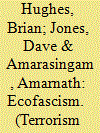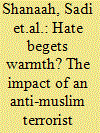|
|
|
Sort Order |
|
|
|
Items / Page
|
|
|
|
|
|
|
| Srl | Item |
| 1 |
ID:
188064


|
|
|
|
|
| Summary/Abstract |
With Patrick Crusuis’ 2019 attack that killed twenty-two people in El Paso, Texas, discussions of ecofascism were thrust into mainstream news outlets and magazines. In his manifesto, Crusius described himself as an “ecofascist” seeking to challenge the “environmental warfare” of immigration. His choice of target, a Walmart frequented by Mexican immigrants, reflects this ideological connection between ecological priorities and violent white supremacist ideology. In this paper, the authors provide a review of existing theoretical literature on ecofascism to identify its key characteristics, namely, its Romantic sensibilities, anti-humanism, and mysticism. The authors argue that these features distinguish ecofascism from what other scholars have deemed “far-right ecologisms.” Following this, the authors draw on a larger corpus of data gathered from Twitter and Telegram between November 2019 and November 2020 to identify common themes in ecofascist circles, including the thinkers they frequently cite. The dataset examined shows notable differences in the types of content shared in ecofascist groups compared to the far-right more broadly.
|
|
|
|
|
|
|
|
|
|
|
|
|
|
|
|
| 2 |
ID:
188086


|
|
|
|
|
| Summary/Abstract |
Following the rise in far-right inspired terrorist attacks globally, social media and electronic communications companies have been criticized, mainly by politicians, for allowing far-right extremist content to be available. This article is a comparative legal study focusing on Australia, Canada, New Zealand, the U.K., and the U.S.’ legal provisions regarding the right to freedom of expression, hate crime, and proscription of terrorist organizations. This study found a disparity in the form of expression protected under this right. This disparity widens further when related to hate crime and proscribing groups as terrorist organizations. As such, social media and communications companies have difficulty setting at global level a baseline in determining whether content is legitimate commentary or is extremism promoting or inciting hatred and violence. The article concludes with a recommendation for how states can provide comparable legislation on hate crime as they have done in relation to Islamist inspired extremism. This will assist social media and communications companies in removing content and suspending accounts. These companies are not the guardians of freedom of expression, that is the role of states’ legislatures and judiciary.
|
|
|
|
|
|
|
|
|
|
|
|
|
|
|
|
| 3 |
ID:
190908


|
|
|
|
|
| Summary/Abstract |
This article examines the impact of the March 15, 2019 far-right terrorist attack against Muslims in Christchurch, New Zealand on public opinion toward Muslims. It also examines whether the impact of the attack varies for individuals across the political spectrum. We make use of data from the 2019 New Zealand Attitudes and Values Study (N = 47,951) to compare the attitudes of New Zealanders before and after the attack. Using a range of statistical techniques, including regression discontinuity analysis, we find robust evidence that the attack led to an immediate increase in warmth toward Muslims. We also show that this increase was driven by both left-wing/liberal and right-wing/conservative individuals in the immediate days after the attack. Soon after the attack, however, attitudes toward Muslims among the politically conservative population tended to revert to pre-attack levels. By contrast, political liberals maintained their heightened level of positive attitudes for a longer period. We discuss the possible theoretical reasons for these findings.
|
|
|
|
|
|
|
|
|
|
|
|
|
|
|
|
| 4 |
ID:
175741


|
|
|
|
|
| Summary/Abstract |
The threat of chemical, biological, radiological and nuclear (CBRN) terrorism is widely attributed to collective actors based on a religious ideology, e.g. globally operating Salafi-jihadist groups like al-Qaeda or ISIL. Only limited attention has been given to the CBRN threat of violent domestic extremists in general or far-right terrorists specifically. Nevertheless, a number of incidents involving far-right activists and CBRN agents in Western countries are known to the public, even though these have had comparatively little impact on public threat perception. This study systematically collected public information about far-right CBRN incidents to identify their main characteristics. The authors were able to identify 31 incidents in Western countries since 1970, which display features contrary to generally assumed forms of CBRN terrorism. Far-right CBRN terrorism appears to be predominantly a lone-actor phenomenon oftentimes involving middle-aged and comparatively well-educated male perpetrators, mostly motivated by non-religious forms of far-right ideology (i.e. neo-Nazism, non-religious white supremacism) and indiscriminately targeting victims. Overall, far-right actors attempting to weaponize CBRN agents have been few and generally technically inept. However, the characteristics of the plots pose potential challenges for effective counter-measures and intervention, should the number of actors or the technical sophistication of plots increase in the future.
|
|
|
|
|
|
|
|
|
|
|
|
|
|
|
|
| 5 |
ID:
167166


|
|
|
|
|
| Summary/Abstract |
This article observes that the cycle of violent political extremism that began in Japan’s postwar period did not last long beyond the mid-1990s. In view of the situation, this article intends to (1) give an overview of the issue, (2) discuss why the frequency and degree of political violence declined, and (3) investigate current trends in Japanese political extremism, as it still appears to exist if we define extremism as more than physically violent behaviors. This article argues that violent extremism as a tactic may have found it difficult to outlive the period of the “developmental state” of Japan, while the era of “civil society” in Japan that followed perhaps rendered ideologically motivated violence irrelevant. This article also argues that, today, acts that can be counted as extremism have morphed into occasions where activists have grievously offended the feelings of the targeted population, thereby gaining notoriety and publicity.
|
|
|
|
|
|
|
|
|
|
|
|
|
|
|
|
|
|
|
|
|